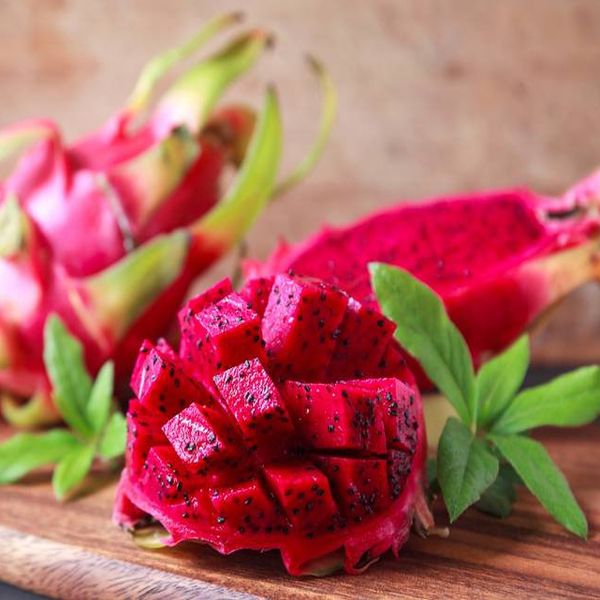Dragon fruit is a tropical fruit that has become increasingly popular in recent years.It goes by many names, including pitaya, pitahaya, and strawberry pear.
Red Dragon fruits, or Pitaya Roja, are botanically classified as Hylocereus constaricensus and sometimes Hylocereus polyrhizus. The former classification references its native Costa Rica. The red-fleshed Dragon fruits are rarer than the yellow skinned variety, and are not nearly as widely available as the white-fleshed variety. Red Dragon fruits are often called Costa Rican Dragon fruit or Purple Pitaya, and sometimes Strawberry Pear Cactus. In the United States, Florida and California produce these brightly fleshed fruits, in the off-season, they come directly from their native Nicaragua or Costa Rica.
Given the high amount of fiber and magnesium, as well as the extremely low calorie content, dragon fruit can be considered a highly nutrient-dense fruit.
Aside from vitamin C, dragon fruit contains carotene, which is linked to several anti-carcinogenic qualities, including reducing a number of tumors. Moreover, lycopene, responsible for the red color in dragon fruit, has been shown to be linked to lower prostate cancer risk. A 2011 study published in the Asian Pacific Journal of Cancer Prevention found lycopene intake of less than 2,498 mcg/day increased the risk of prostate cancer, whereas a higher intake of fruits, vegetables, and lycopene-rich foods, including being physically active, can significantly reduce the risk.
Moreover, the peel of dragon fruit contains polyphenols, which are chemicals often found in nature. “There is the possibility that some of these polyphenols work as affinities to estrogen receptors and possibly alter the attachment behavior of this and other hormones to their receptor sites on cells,” Meehan said. “This could be one reason why it may protect against certain forms of cancer.”
Animal studies suggest that dragon fruit may provide various health benefits.
Red Dragon fruit contains high amounts of vitamin C and has a high fiber content. They are also a good source of potassium and phosphorus, as well as other minerals and B-complex vitamins. Red Dragon fruit is rich in protein, antioxidants (from the betacyanins), lycopene and carotene. Dried Red Dragon fruit has ten-times the nutritional benefits of the fresh fruit. The benefits of Dragon fruit include improving the health of the eyes and skin, including protecting the skin from ultraviolet damage. Eating too much fresh Red Dragon fruit can cause a laxative affect.
Red Dragon fruit is often eaten raw, scooped with a spoon directly from the rind. Many prefer to refrigerate the fruits prior to eating, to chill the pulp within. Slice the fruit lengthwise or in half to expose the seeded flesh. The pulp can be added to smoothies or used to make sorbet and other desserts. Remove the flesh with a melon-baller and add to green or fruit salads for a topical addition. Red Dragon fruit will stain the skin and clothing, use care when preparing. Store Red Dragon fruit in a plastic bag in the refrigerator for up to three weeks. The fruit can be frozen for up to a year when sealed in a plastic bag. Red Dragon fruit can also be dried to preserve.
Dragon fruit is a low-calorie fruit that contains less sugar and fewer carbs than many other tropical fruits.
It may offer some health benefits, but human studies are needed to verify this.
Overall, dragon fruit is unique, incredibly tasty, and can add variety to your diet.
Post time: Jun-23-2020
